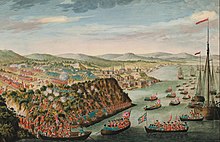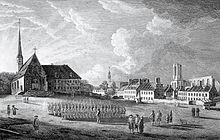
The French and Indian War (1754–1763) was a theater of the Seven Years' War, which pitted the North American colonies of the British Empire against those of the French, each side being supported by various Native American tribes. At the start of the war, the French colonies had a population of roughly 60,000 settlers, compared with 2 million in the British colonies. The outnumbered French particularly depended on their native allies.
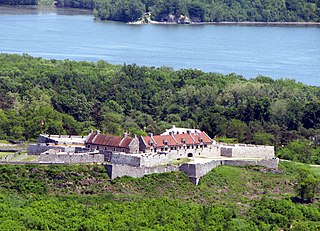
Fort Ticonderoga, formerly Fort Carillon, is a large 18th-century star fort built by the French at a narrows near the south end of Lake Champlain, in northern New York, in the United States. It was constructed by Canadian-born French military engineer Michel Chartier de Lotbinière, Marquis de Lotbinière between October 1755 and 1757, during the action in the "North American theater" of the Seven Years' War, often referred to in the US as the French and Indian War. The fort was of strategic importance during the 18th-century colonial conflicts between Great Britain and France, and again played an important role during the Revolutionary War.

The Battle of Sainte-Foy sometimes called the Battle of Quebec, was fought on April 28, 1760 near the British-held town of Quebec in the French province of Canada during the Seven Years' War. It was a victory for the French under the Chevalier de Lévis over the British army under General Murray. The battle was notably bloodier than the Battle of the Plains of Abraham of the previous September, with 833 French casualties to 1,124 British casualties.

The Battle of Carillon, also known as the 1758 Battle of Ticonderoga, was fought on July 8, 1758, during the French and Indian War. It was fought near Fort Carillon on the shore of Lake Champlain in the frontier area between the British colony of New York and the French colony of New France.

The Battle of the Plains of Abraham, also known as the Battle of Quebec, was a pivotal battle in the Seven Years' War. The battle, which began on 13 September 1759, was fought on a plateau by the British Army and Royal Navy against the French Army, just outside the walls of Quebec City on land that was originally owned by a farmer named Abraham Martin, hence the name of the battle. The battle involved fewer than 10,000 troops in total, but proved to be a deciding moment in the conflict between France and Britain over the fate of New France, influencing the later creation of Canada.

James Wolfe was a British Army officer known for his training reforms and, as a major general, remembered chiefly for his victory in 1759 over the French at the Battle of the Plains of Abraham in Quebec.

Louis-Joseph de Montcalm-Grozon, Marquis de Montcalm de Saint-Veran was a French soldier best known as the commander of the forces in North America during the Seven Years' War.

Admiral of the Blue Edward Boscawen, PC was a British admiral in the Royal Navy and Member of Parliament for the borough of Truro, Cornwall, England. He is known principally for his various naval commands during the 18th century and the engagements that he won, including the siege of Louisburg in 1758 and Battle of Lagos in 1759. He is also remembered as the officer who signed the warrant authorising the execution of Admiral John Byng in 1757, for failing to engage the enemy at the Battle of Minorca (1756). In his political role, he served as a Member of Parliament for Truro from 1742 until his death although due to almost constant naval employment he seems not to have been particularly active. He also served as one of the Lords Commissioners of the Admiralty on the Board of Admiralty from 1751 and as a member of the Privy Council from 1758 until his death in 1761.
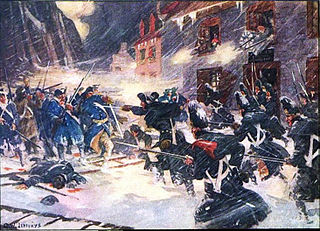
The Battle of Quebec was fought on December 31, 1775, between American Continental Army forces and the British defenders of Quebec City early in the American Revolutionary War. The battle was the first major defeat of the war for the Americans, and it came with heavy losses. General Richard Montgomery was killed, Benedict Arnold was wounded, and Daniel Morgan and more than 400 men were taken prisoner. The city's garrison, a motley assortment of regular troops and militia led by Quebec's provincial governor, General Guy Carleton, suffered a small number of casualties.

The 1759 Battle of Ticonderoga was a minor confrontation at Fort Carillon on July 26 and 27, 1759, during the French and Indian War. A British military force of more than 11,000 men under the command of General Sir Jeffery Amherst moved artillery to high ground overlooking the fort, which was defended by a garrison of 400 Frenchmen under the command of Brigadier General François-Charles de Bourlamaque.

Events from the year 1759 in Canada.

Events from the year 1760 in Canada.
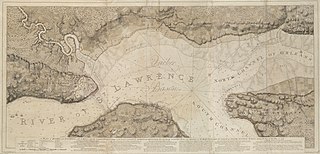
The Battle of Beauport, also known as the Battle of Montmorency, fought on 31 July 1759, was an important confrontation between the British and French armed forces during the Seven Years' War of the French province of Canada. The attack conducted by the British against the French defense line of Beauport, some 5 kilometres (3.1 mi) east of Quebec was checked, and the British soldiers of General James Wolfe retreated with 443 casualties and losses.

The Battle of the Thousand Islands was an engagement fought on 16–24 August 1760, in the upper St. Lawrence River, among the Thousand Islands, along the present day Canada–United States border, by British and French forces during the closing phases of the Seven Years' War, as it is called in Canada and Europe, or the French and Indian War as it is referred to in the United States.

François-Gaston de Lévis, 1st Duke of Lévis, styled as the Chevalier de Lévis until 1785, was a nobleman and a Marshal of France. He served with distinction in the War of the Polish Succession and the War of the Austrian Succession. During the Seven Years' War, he was second-in-command to Louis-Joseph de Montcalm in the defense of New France and then, after the surrender of New France in 1760, he served in Europe. After the war, he was appointed Governor of Artois, and in 1783 he was made a Marshal of France.

The siege of Louisbourg was a pivotal operation of the Seven Years' War in 1758 that ended the French colonial era in Atlantic Canada and led to the subsequent British campaign to capture Quebec in 1759 and the remainder of French North America the following year.
Jean-Baptiste Nicolas Roch, Seigneur de Ramezay, (4 September 1708, in Montreal, New France – 7 May 1777, in Blaye, France; officer of the marines and colonial administrator for New France during the 18th century. Joining at age 11, as an ensign, he fought campaigns against the Meskwaki tribe in Illinois, and the British in Acadia. In 1759, during the Seven Years' War, as the King's lieutenant; he signed, in the name of Louis XV, the Articles of Capitulation of Quebec, for which he was later criticised.
John Knox was an officer in the British Army who took part in the Austrian War of Succession and the Seven Years' War. He served in North America between 1757 and 1760 and is notable for providing historians with the most complete account of these campaigns. Knox narrowly avoided being killed in 1759 when a French soldier's musket twice misfired, and he went on to fight in the Battle of the Plains of Abraham, where he performed in one of the most devastating volleys in military history. Knox also took part in the Battle of Sainte Foy and was present when Montreal surrendered on 8 September 1760.

The Battle of Pointe-aux-Trembles was a naval and land engagement that took place on 16 May 1760 during the French and Indian War on the north shore of the Saint Lawrence River. It was near the present-day village of Neuville, in New France, during the French siege of Quebec. A relief force of the Royal Navy, having forced a passage through ice up the Saint Lawrence River, destroyed the French ships led by Jean Vauquelin that were assisting in the French siege of Quebec. The British victory forced the French under Chevalier de Lévis to raise the siege and to end their attempts to retake Quebec City.

The Montreal campaign, also known as the fall of Montreal, was a British three-pronged offensive against Montreal which took place from July 2 to 8 September 1760 during the French and Indian War as part of the global Seven Years' War. The campaign, pitted against an outnumbered and outsupplied French army, led to the capitulation and occupation of Montreal, the largest remaining city in French Canada.

